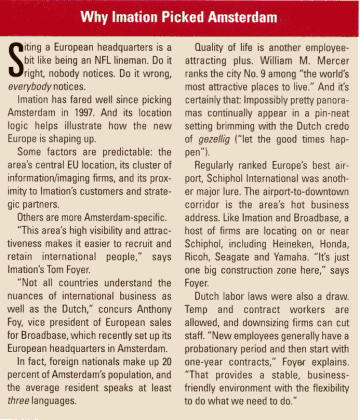A onetime jazz saxophonist with the likes of the Tommy Dorsey Orchestra and Lou Rawls, Imation executive Thomas Foyer muses that the song in part remains the same.
“Today’s business environment is like jazz because it’s moving so fast. You have to improvise, keeping the group small enough so you can make changes quickly,” says Foyer, Imation Europe Director of Finance and Information Management Systems (IMS).
 “And you have to constantly listen to your audience, getting information from them, knowing what they want, so they will listen to you,” continues Foyer, who’s sitting in Imation’s seven-story European headquarters in Amsterdam. “Likewise, our Oracle system keeps all Imation’s core activities in synch, which is very much like jazz, where the musicians are constantly in touch with one another.”
“And you have to constantly listen to your audience, getting information from them, knowing what they want, so they will listen to you,” continues Foyer, who’s sitting in Imation’s seven-story European headquarters in Amsterdam. “Likewise, our Oracle system keeps all Imation’s core activities in synch, which is very much like jazz, where the musicians are constantly in touch with one another.”
The jazz analogy is relevant here in plumbing the sweet music Imation’s making with its focus on data storage and imaging. Fortune‘s 1999 scorecard, compiled from corporate executives and securities analysts rankings, rated Imation No. 3 in the “computer peripherals” sector, trailing only No. 1 EMC and No. 2 Lexmark International. That’s a significant upswing from Imation’s No. 6 slot in the 1998 rankings.
ABOVE RIGHT: Imation’s headquarters near Schiphol International
ABOVE LEFT: “Facilities, IT and finance are always having to communicate with each other to
service the customer,” says Foyer. “So keeping them together keeps the focus on the customer.”
Things weren’t always so. Outside the European headquarters stands an apt visual metaphor: a small lake, where Imation’s logo rises on a silver crescent.
 Only a few years ago, Imation (www.imation.com) was struggling mightily to stay afloat. It found its business rhythm only after painfully defining a clear corporate focus. And that focus squarely caught the wave of globalization and technology, the twin forces shaping today’s business environment.
Only a few years ago, Imation (www.imation.com) was struggling mightily to stay afloat. It found its business rhythm only after painfully defining a clear corporate focus. And that focus squarely caught the wave of globalization and technology, the twin forces shaping today’s business environment.
At the same time, Imation’s European operations reflect a continent verging on seizing its own powerful focus. Europe is awash in change, not only in its economic and political structure, but in its information infrastructure as well.
Those colliding changes are having a major impact on the how’s, where’s and why’s of European facility operations. And they’re aligning to create major opportunities for Imation.
ABOVE RIGHT: “In the future, with all costs in Euros, it will be easier to make
real estate comparisons, but we do not yet have that,” Innocenti says.
Keeping the Infrastructure Integrated
From a conference room inside the leased headquarters at the Amsterdam Airport Area, Foyer puts a finger on the beat that’s driving Imation. “We’re lean and mean here,” he says. And the Imation model in many ways recalls the stripped-down quintets that made Miles Davis a musical colossus. Operations are pared to the essentials, then meshed in constant concert.
Take infrastructure integration. A host of firms are throwing huge resources into fusing key corporate support functions like real estate, IMS, finance and human relations (HR). That effort has been led by the groundbreaking research of the International Development Research Council (IDRC), the world’s preeminent corporate real estate association, which has made Corporate Infrastructure ManagementTM (CIM) a touchstone.
But Imation hasn’t had to fight the CIM war of putting Humpty Dumpty back together again. Imation never let Humpty fall. Facilities, IMS and finance, for example, are linked under Foyer’s charge — and they’ve always been.
“When Imation was spun off from 3M in July of 1996, we had that sort of strategic direction from the outset, though pieces of HR and communications are sitting out on one side,” says Foyer. “Facilities, IT and finance are always having to communicate with each other to service the customer. So keeping them together keeps the focus on the customer.”
That’s pharmaceutical-strength CIM logic, and Imation is expanding it.
“The strategic direction we’re going in now is that finance, facilities, IMS and, to an ever greater extent, even customer service are increasingly merging into one local-level operations team,” Foyer explains. “The business units can then completely focus on sales and marketing without the burden of any local administrative work. In each country a senior administrative manager from our unit drives all the pieces to make sure they support the business units.”
Enabling IT has added even more heft to the integration logic, Foyer says.
“All of those infrastructure pieces are already in our Oracle system. So you’re looking to one source of data, which also helps pull the organization in one direction.”
But it’s no mean feat that Imation has kept its CIM Humpty Dumpty intact. The Oakdale, Minn.-based operation is well past the size breakpoint at which infrastructure usually begins to fragment. In 1999, for example, Imation’s work force grew 24 percent, increasing to 4,850 on sales of $1.4 billion, a 31 percent annual upswing.
Creating a Consistent European Workplace
Imation has also rapidly become an international player; more than half its sales come from outside the United States. Europe in particular is a key market. “It’s our fastest-growing market right now,” says Foyer.
With its high-end product niche, Imation has established a major presence inside Europe’s biggest, most lucrative markets. It has sales offices and third-party warehouses in Athens; Bracknell, England; Dublin; Neuss, Germany; Cergy, France; Milan and Madrid. All inside the European Union (EU), those locations provide a strong market position.
Location is one thing, though. Creating a consistent, productive workplace is another — particularly within the EU’s rich cultural tapestry. That diversity has stalled more than a few corporate workplace initiatives.
Inside Imation’s Netherlands headquarters, airy, attractive cubicles sit in the center of the workspace. Each cubicle grouping has a small table at its center for team meetings. Larger, door-less spaces line the facility’s periphery. The emphasis is clearly on open communication across a flat hierarchy.
And that workspace is Imation’s European prototype, explains Sandro Innocenti, European manager of facilities and purchasing.
“We began in Europe with the model our U.S. headquarters dictated, with eight-ft.-by-eight-ft. (2.43-m.-by-2.43-m.) cubicles, plus 12-ft.-by-12-ft. (3.66-m.-by-3.66-m.) spaces for those above the director level,” Innocenti says.
The model is moving toward EU-wide implementation.
“We have been very consistent so far,” says Italian native Innocenti. “In Germany and Italy we have the same office model you see here.” Imation’s Spanish and UK offices employ different configurations, “but they will eventually also conform to this model,” he adds. Only Imation’s French facility will retain its more open-office design, largely due to the facility’s rounded shape.
“We are completely open; we don’t have any offices with doors in this building,” Foyer notes. “Overall, our European operations, like our entire company, follows the cube.”
Culturally Ticking the Model
But no major workplace alteration comes without friction.
“You always have some resistance to change, and we had some in introducing this workplace model in Europe,” says Gonnie Been, Imation Europe corporate communications manager. “Overall, though, it was a smooth transition, made easier by being part of European high tech, where this sort of configuration is widely accepted.”
Imation, however, has ticked its model to accommodate cultural variations.
“Different nations’ habits caused some amendments,” Innocenti says. “In the Netherlands, we have the PC monitor in the cubicle’s corner, while in Germany the monitor is in front of employees, facing 90 degrees from the light,” Innocenti adds. In France, Imation’s employees, face a chair, not a wall, accommodating their preference for meetings at desks, not conference rooms.
Imation’s emphasis on open communication, however, remains consistent, Foyer says.
“We found we have to give a bit more privacy to people doing highly individual or confidential work, like an attorney working on contracts, negotiating and making confidential phone calls,” the Chicago native explains. “Overall, though, we try to configure the workplace so everyone sees everyone else. That’s really increased inter-group collaboration.”
The ‘Euro Zone’ Hotspot
A different collaboration — the European Monetary Union’s (EMU) common currency — is looming larger in location strategies like Imation’s.
Eleven of the 15 EU nations signed on as part of the EMU’s first-phase “Euro zone”: Austria, Belgium, Germany, France, Finland, Ireland, Italy, Luxembourg, the Netherlands, Portugal and Spain. Greece will join on Jan. 1, 2001, leaving only Denmark, Sweden and the UK as Euro holdouts. (Denmark is holding a September EMU referendum.)
But while the EMU began on Jan. 1, 1999, the Euro won’t physically appear until Jan. 1, 2002. Even so, the EMU’s exchange-rate linkage is significantly affecting foreign direct investment (FDI). Ernst & Young’s (E&Y at www.ey.com) European Investment Monitor reports that the 11 EMU nations in 1999 collectively recorded a 10 per cent net overall increase in FDI projects. In contrast, 1999 FDI projects in non-EMU nations dropped 18 percent.
Obviously, the Euro’s weakness against the dollar and pound partially accounts for those changes.
Still, E&Y International Location Advisory Services Director Barry Bright asserts, “The implications of these results cannot be ignored. . . . Investors are looking for cost-effective locations and consistent transaction values among their supplier and customer bases. This is more difficult to achieve with non-Euro participation [with] exchange-rate risk and the requirement to manage volatility in mid-transaction.”
The Euro is particularly contentious in the UK, says the London-based Bright.
“Toyota’s vote for France [for its new $1.6 billion auto plant] is a palpable expression of investors’ increasing disaffection with non-Euro economies,” he contends. “Nissan in the UK’s Northeast has already voiced reservations about the UK’s non-Euro participation. BMW, which highlighted the negative effect on its business of the high pound throughout the Rover debacle, also referred to its need for stability of costs within its supply chain.”
But the issue won’t be easily resolved. In a summer poll, 72 percent of Britons opposed Euro adoption.
Real Estate Costs Remain Uneven
An established European player, Imation sees its greatest Euro payoffs in the future.
“We’re only 5 to 10 percent into implementation, so it’s too early to see the long-term impact,” Foyer says. “But I do think the Euro will really help European business expansion by making it easier to move capital.”
The Euro’s impact on Imation’s real estate has been minimal, Innocenti says.
“In the future, with all costs in Euros, it will be easier to make real estate comparisons, but we do not yet have that,” he says. “It is one thing to have one currency, but another thing to have the same pricing policy and structure. There are still strong differences in Europe between the cost of the same thing.”
Adds Been, “Consumables will be differently priced within Europe for a long, long time. But in a business-to-business environment like ours, yes, companies shouldn’t have to pay a different price.”
Pricing variations were apparent when Imation changed its European server system, Innocenti explains. “For each facility, we bought the same model with the same components,” he says.
“Yet we had a different server costs in each location, even though all prices were transferred into Euros.”
‘Infostructure’ Spurring Bigger Changes
The deregulation-driven shakeup in Europe’s “infostructure” promises more immediate impact.
“Combine globalization’s thrust, the e-commerce surge and the Euro, and you’ll see e-commerce blow through Europe like a whirlwind,” says Tim Caiger, Oracle vice president of real estate for Europe, the Middle East and Africa.
Already, says E&Y’s Bright, Europe’s emerging e-conomy is changing the nature of FDI.
“We believe we’re seeing an end to the established order of European FDI [of] the last 10-15 years, [when] the focus was on manufacturing and location choices driven by cost and incentives,” Bright asserts. “Today, e-business locations . . . are less driven by cost and more by entrepreneurial culture, the presence of e-skills, cities’ attractiveness and infrastructure.”
That new-age location influx is reflected in the hordes of pan-European telecom services now entering the market. European Internet adoption is running three years behind the United States, according to E&Y research. But with faster, cheaper telecom, Europe will soon register the same strong demands for data/image storage and management that are now sweeping the United States.
That, of course, runs right up Imation’s product alley. For example, early this year Imation shipped its one millionth SuperDisk USB Drive, a high-capacity, floppy-compatible storage device designed for Apple’s new family of iMacs. And in the spring Imation released a product with huge e-commerce potential: Verifi, which ensures accurate online color by adjusting to users’ monitor specifications.
“The new pan-European telecom networks and services will make it a better market for us,” says Foyer, who’s lived in Europe for 10 years. “Products like Verifi will become part of the infrastructure for these high bandwidth networks.”
 Shrinking to Get Stronger
Shrinking to Get Stronger
Imation faces a ton of changes in Europe. But change was fairly drilled into its DNA. An unwieldy hodgepodge of 3M’s most unprofitable businesses, Imation posted a first-year loss of $180 million.
Only 9,700 of the 12,700 former 3Mers initially became part of Imation. More soon vanished. Imation slashed two management layers, five plants and seven R&D labs. It offloaded business lines that didn’t fit its future, including medical imaging, which Kodak bagged for $520 million.
“After the spin-off we had all sorts of functions,” Foyer says.
“By paring back, we’ve gotten much stronger, focusing on what we see as our core competencies — data storage and imaging management.”
In the spring of 1997, for example, 65 percent of Imation’s sales came from mature lines. Today, 70-plus percent comes from e-conomy-friendly data storage and imaging. That’s made 3M’s leftovers something of a leftoverture: First-quarter 2000’s gross margins were a bullish 31.2 percent.
New Europe ‘Definitely Coming’
Given Europe’s myriad changes, Imation can anticipate a continental market with bigger profits — and bigger boundaries.
Already, many firms are altering location strategies for “the greater European market.” By 2010, analysts envision a market spanning the EU, all of Eastern Europe, Russia and the Ukraine — 800 million people strong, double the NAFTA market’s size. No wonder Europe has displaced the Asia-Pacific as the second most popular region for FDI.
Foyer, who left jazz for his even keener interest in business, sees great things coming from the EU. But some haven’t yet arrived, he forthrightly adds. Imation, for example, totally outsources warehousing and distribution. In Europe, though, it can’t find a single-source provider.
“There isn’t yet one pan-European provider with the high-quality service to cover everywhere,” Foyer says. “European businesses are still going through the restructuring and cost-cutting that’s already happened in the U.S.”
But open-market competition has a Darwinian way of unscrambling things, as it’s doing in Europe.
“In distribution and logistics, we’re already seeing consolidation toward a pan-European model,” Foyer says. “And as the workforce becomes more flexible across Europe, business expansion is going to increase.
“So it’s coming. It’s definitely coming.”

